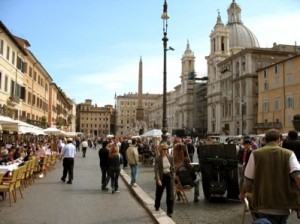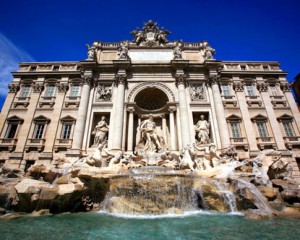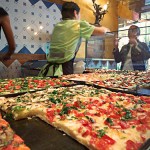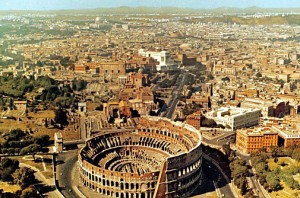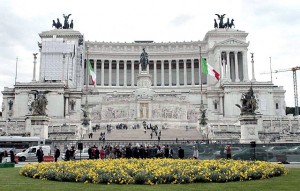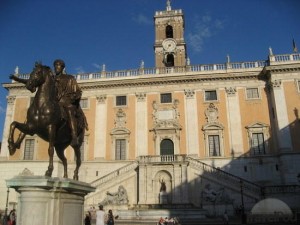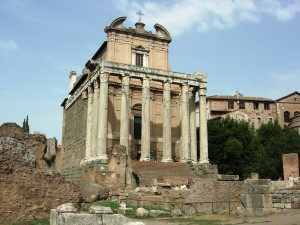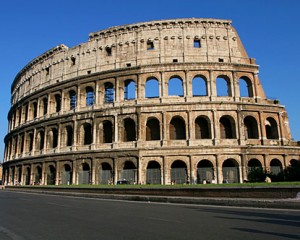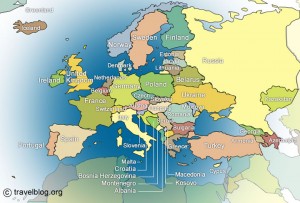
While at school, I never understood how the study of European history and geography was going to help us. However, slowly and steadily my studies painted vivid images that began to fascinate me. Over the years the urge to visit these places grew.
I was fascinated by the snow clad mountainous regions of Switzerland, the plains below sea level in Holland, the canal network of Venice, the historical ruins of Rome, the leaning Tower of Pisa, the serene Rhine river, the castles of Germany & England and the various crafts, industries and ports.
I was also fascinated by maritime adventurers like Columbus, Vasco-Da-Gama, Marco Polo; artists and sculptors like Leonardo Da Vinci and Michelangelo and the art loving people of Florence. The aspiration to view European life at close range, remained until the urge became so strong that I was finally compelled to visit Europe. My wife and I decided on a 19-day tour of Europe.
It took us nearly a year to get our passports in hand. Finally, on 25th June 2001 we boarded the Swiss Air flight from Mumbai. A group of 50 people from other parts of India joined us at Zurich Airport. The gleaming portals of the airport and the beauty of the landscapes enthralled me. We were escorted to a modern bus that boasted a GPS screen linked to a satellite. The young Italian driver, Antonio, delightedly shouted out that Sonia Gandhi was from his country. During the tour, it was fascinating to watch Antonio follow the detailed directions indicated on the screen.
We visited Europe’s largest and most powerful waterfalls on the beautiful Rhine, where the waters foamed and created mist that enveloped us. En route to Zurich, we faced an unexpected and unusual traffic jam. Despite the unaccustomed frustration of six lanes inching their way at snail’s pace, not a horn blared, nor did a single vehicle attempt to change lanes. A traffic police helicopter soon arrived and cleared the traffic.
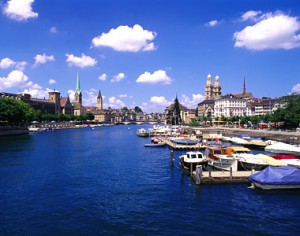
Zurich
Zurich, the financial capital and the biggest city in Switzerland was picture postcard perfect. Buses, trams and trains run on electricity and all other vehicles adhere to strict emission norms. To facilitate a cleaner environment, the Govt. is considering transporting all vehicles passing through the country on electric trains.
Zurich is on the wooded slopes of a mountain range at the confluence of two rivers. The main street is lined with banks, shopping arcades and exclusive boutiques. We passed by the Swiss National Museum and St. Peter’s Church with the largest clock face in Europe, and spent some time beside Lake Zurich. Hotel Terrace, in the small town of Engelburg, where we stayed, has to be reached by cable car as it is located at an altitude. When I stepped out onto the balcony, I was startled to find the stunning snow-clad mountain peaks still sunlit at 10 p.m.
We drove to Lucerne, the sixth most visited city in the world. The city is located around the lake. We saw the Lovendenkal, the Lion monument. etched on limestone on a hillside built to commemorate the bravery and loyalty of Swiss Guards. At the Bucherer showroom, one of Switzerland’s well-known watch manufacturers, we bought two beautifully carved spoons as souvenirs. On our way to the scenic Lake Lucerne, we saw the famous and the oldest, covered wooden bridge of Kappelbrucke. Originally built in 1333 over the Reuss River, the bridge leads to a beautiful 17th century Jesuit Church. The cruise on the lake was enchanting.
The following morning we went to see Mt. Titlis, which at 10, 000 feet, is the highest peak in central Switzerland. From Engelburg town, three types of cable cars, including the rotating Titlis Rotair, us to the snow-clad peak of Mt. Titlis. The Ice Flyer, another chairlift, spans the glacier crevasses of Mount Titlis. We slipped and slid through the Ice Cave, a man made tunnel carved through a glacier.
The next day we were scheduled to visit Venice and I was already looking forward to the fascination of discovering other destinations, long imagined in my mind.
On the third day of our tour, we set out to visit Venice, the romantic ‘Canal City’. The drive from Switzerland to Italy took us via picturesque lakes and tunnels, including the world’s longest 17 km road tunnel, St. Gotthard Tunnel. On either side of the road varieties of flowers bloomed on sunlit hillsides. We would get tantalizing glimpses of clusters of tiled houses in a variety of shapes, shades and colours, with flower pots artistically arranged on balconies and windows. We crossed a railroad bridge over Lake Lugano. Switzerland was simply stunning in its beauty.
Reaching the border at noon we converted our Dollars into Lire. We were amused to see ten US Dollars equivalent to 20, 000 Lire and joked at or immediate status of becoming millionaires. However, the money as swiftly flowed through our fingers, with 1000 Lire, equivalent to Rs 40, being spent to use toilet facilities.
We reached the enchanting city of Venice, a conglomeration of three lagoons, by motorboat in the afternoon. The entry through Guidecca Canal presented a beautiful view with palaces and clock towers lining the canals. The renowned gondola, used as transport, affords easy maneuverability. A few years earlier most of the city’s buildings had been submerged due to floods.
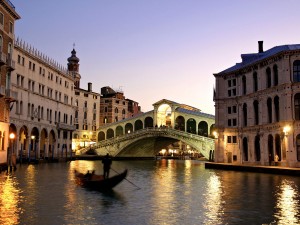
A Gondola by the Rialto Bridge, Venice
Venice is a charming city with enthusiastic and friendly people. Tourists crowd St. Mark’s Square, watching pigeons flying and resettling to peck the grain offered them. With the beautiful Doges Palace, St. Marks Basilica and the Clock Tower adjoining it, the picturesque Square has been the subject of many colorful paintings by well-known artists. ‘The Bridge of Sigh’, was crossed by convicted prisoners after their trial. It was from this bridge that they saw the world for the last time, before their execution on the other side.
St. Marks Basilica, the 11th century Byzantine Cathedral, is one of the most awe-inspiring and magnificent churches of the world. Inside is Titan’s famous painting, the ‘Last Judgement’. The Doges palace, Palazzo Ducale, next to the Basilica, is a pink marble structure with immense rooms and is one of the treasure houses of the world.
The population of Venice city is a mere 100, 000 but it draws 8 million tourists every year! The city, founded by Romans in 1st Century AD, became a wealthy independent trading republic in the 10th century. The enterprising people of Venice have long been trading quality merchandise like jewellery, glass, lace and carpets.
Italy recognizes no cultural barriers. Roman Frescos of Pompeii, brilliant mosaics of St. Mark’s, paintings of Angelico, Bottacelli, Leonardo-Da-Vinci, Michelangelo, Ballimis, Titan, Tintorello, Modigliani, Giorgeode and Chirico, all add to the glory of this mighty historical land. The Romans, who discovered cement, used it to build Europe’s first sky scraper, the Colosseum. Italy has also produced great musicians like Bellini, Donizzeli, Verdi, and Puccani.
Next on our itinerary was Florence. En route, we stopped to check out the famous Italian leather products. We reached Florence at midday and had lunch at an Indian dhaba run by a Sikh gentleman from Punjab.
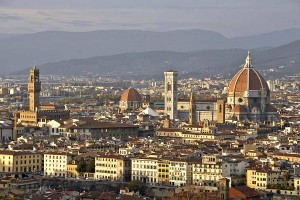
The Florence Skyline
Florence is the capital of Tuscany region and has a population of over 4, 00, 000. The ancient monuments are located at the center of the city while the suburbs sport a modern look. Renaissance citizens, including writers Dante and Boccacio and artists like Giotto, Leonardo da Vinci and Michelangelo, were from Florence. Established by the Romans in 1st century B.C., Florence reached the peak of its prosperity in the 16th century AD.
The Architectural treasures of Florence include the Ponte Vecchio, the 1345 A.D Pitti Vecchio palace, the churches of Santa Croce and Santa Maria Nivella, Cathedral of Santa Meriodel, Flora of 1314 A.D, and Uffizi Gallery, which has an exceedingly fine art collection. The Giant Dome of Piazza del Duomo, designed by Brunellochi has an immense fresco, Universal Judgement, rendered by Vasari & Zuccari. Beside it, the beautiful 14th century bell tower, the Campanile, rises to a height of 292 ft. On the opposite side is the Baptistry of San Giovanni with Ghibert’s greatest work, the East Door, also nicknamed by Michelangelo as the Gate of Paradise. It took 27 years to complete this matchless work in bronze. An easy walk from Palazzo Del Duomo, is the City Hall, once the palace of Della Signora also called Palazzo Vecchio (the old palace) built between 1298 A.D and 1314 A.D.
There is a replica of Michelangelo’s David, on the right of the old palace. The original marble sculpted David is with the Academy. Next to Palazzo Vecchio is the 14th century Loggio Della Signora with famous sculptures by Giamobolegno, Benevanto, Cellini and others. Nearby is Piazze Degli Uffizi, the Uffizi palace, which houses an important collection of paintings. The memories of these monuments and sculptures will remain with me forever.
We visited Santa Croce Church, the largest and most beautiful of all Italy’s Franciscan churches, in whose burial grounds lie Michelangelo, Dante, Gelilio and others. We also explored the lovely four-mile promenade, which reaches a height of 340 feet at Piazzale Michelangelo. Here we caught a glimpse of Michelangelo’s statue of David and were rewarded with a splendid view of the city.
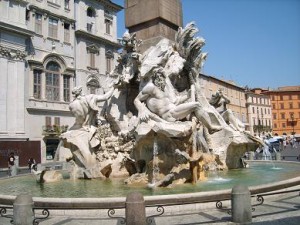
The Fountain of Bernini at the Piazza Novona, Rome
The next morning, we drove to the eternal city of Rome. Founded in the year 753 B.C., the all-conquering Roman Empire ruled for centuries and its end saw the dawn of Christianity. We first visited the ruins of the mighty Colosseum. Built in 76 AD, this monument could house 5000 spectators and was the hub of activity for hundreds of years. Here gladiators fought, chariot races run and Romans ruthlessly punished followers of Christianity in the arena.
Romans believed that when the Collosseum falls, Rome would fall marking the beginning of the end of the world.On one side of the Collosseum is the Arch, erected by Constantine, the first Christian Monarch of Rome. Its beautiful structural design was duplicated by Napoleon for the Victory Gate at Paris and reminded me of the Gateway of India at home in Mumbai.
Half a mile from the Colosseum is the marvelous white Victor Emmanuel Memorial known as the Country’s Altar, built to commemorate the 50th Anniversary of Italian reunification. A little distance away lie Rome’s greatest archeological treasures, the ruins of the mighty old Roman Empire.
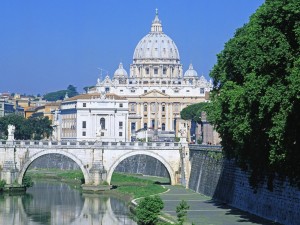
St Peter’s Basilica, Rome
There was bright sunshine at noon when we reached St. Peters Church, the heart of Vatican City. The Vatican is the world’s smallest independent sovereign state and St. Peter’s Cathedral here is the world’s largest church. On both sides of the church are impressive statues of St. Peter and St. Paul. In one hand, St. Peter holds the key to the gates of Heaven. We entered St. Peter’s Basilica where stunning images and sculptures adorned the interior and exteriors. In the Portico, is Michelangelo’s, Pieta, the sculpture of Mother Mary holding the emaciated and immobilized body of Jesus.
The enormous Piazze San Peibro, a quadruple colonnade, took Brunni ten years to build. The beautiful square can hold 40, 000 people. Since our visit coincided with St. Paul’s day, we were fortunate to witness the Pope addressing a huge gathering from a window in a building next to St. Peters Basilica.
Later, we proceeded to Trevi Fountain. This fountain, with a splendid white palace-like structure in the backdrop, draws huge crowds of travellers who drop coins into the fountain in the legendary belief that it will ensure another visit to Rome.
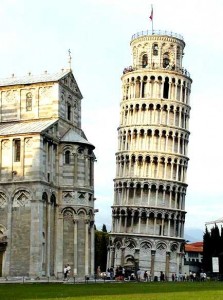
The Leaning Tower of Pisa
Early morning, we headed to one of the Wonders of the World, the Leaning Tower of Pisa. The huge bell tower, tilts to one side, giving it an incredible image of a six-storied structure in the process of falling down. This tilt is the result of a flaw in the structural design at the time of its construction in 1173 A.D
That same evening we again took a scenic drive to return to Switzerland. Early next morning we visited the snow-clad Jungfro at 13, 000 ft. A cogwheel train took us from the base of the mountain through snowy mountain passes and glittering lakes. From the Spinx Terrace at a height of 11, 133 ft., we could see the Aletsch Glacier as well as the Jungfrojoch peak. We marveled at the magnificent ice sculptures in the Ice Palace.
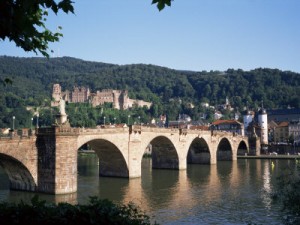
The Old Bridge Over the River Neckar, with the Castle in the Distance, Heidelberg, Germany
On our way to Heidelburg in Germany, we passed through the picturesque Black Forest. The River Neckar flows through Heidelberg, surrounded by forests and mountains. The old town, Alstadt transports one into the past with its cobblestone streets and ornate buildings. The wayside restaurants in the market square that hosts the Fountain of Hercules were doing brisk business. On the side of Konigstel mountains, the old town offered a view of the Heidelburg Castle.
Early next morning, after having our usual continental breakfast, we set out to pass through the Rhine Valley. Lunch usually consisted of bread, roti, a vegetable dish, curd, fruit and pickles. During long journeys, we would generally stop to have packed lunch.
The cruise through the Rhine River passes through rocky terrain affording glimpses of medieval castles and well-laid out towns. In the evening we reached Cologne, famous for Eau De Cologne and Germany’s most visited monument, the Cologne Cathedral. The construction of the Cathedral took almost six centuries. Its imposing Gothic structure is 515 ft. tall with impressive corridors and beautiful coloured glass panels. Just before dark, we reached Rotterdam in Holland.
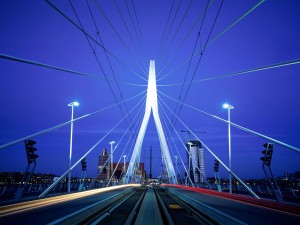 The Erasmus Bridge, Rotterdam
The Erasmus Bridge, Rotterdam
Rotterdam is a modern city and one of Europe’s busiest ports since the 12th century AD. Devastated in World War II, it has risen like the legendary Phoenix from the ashes. Motorways in Holland zip through flush green landscapes. Holland has a history of hard struggle with half the land being reclaimed and generations having worked to keep it from slipping back into the sea. Dikes have been built everywhere. Picturesque windmills and flower gardens dot the countryside.
The Dutch have a very progressive attitude towards sex. Gay marriage and prostitution is legalised. Sex workers advertise on T.V., and adult movies feature on T.V. channels.
We went to Amsterdam, a delightful city and the second biggest port of Holland. We visited a diamond-cutting factory but the articles on sale were too expensive for my taste. We boarded a glass-roofed boat for a sight seeing tour and saw many historical monuments while cruising on the canals. As the city is congested, many families reside in houseboats. These houseboats are beautiful indeed, with exquisitely decorated flower arrangements. We were delighted to see Rembrandt’s house, the clock tower that he painted and a maritime museum with vintage ships anchored around. With a long history of art, Dutch artists like Rembrandt, Jan Vermeer and Van Gogh were masters in their field.
We visited a wooden shoe factory and in the afternoon, drove to Hague, the political capital of Holland where The International Court of Justice is situated.. There was a brief stopover at Madurodam, named after a Dutch Soldier who died in the war. This is a miniature city, personified to the tiniest detail on a scale of 1:25. It picturises how a typical Dutch city developed through the centuries with turning windmills, boats sailing the canal and trains running to and fro between stations. From there, we crossed the border, moving into Belgium.
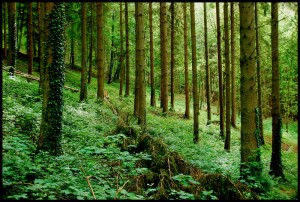
The Ardennes Forests
The scenic forests of the Ardennes have an old world charm. Caesar called the Belgians the bravest of the Gallic tribes. Previously ruled by Austrians, French and Spanish, Belgium gained independence from Dutch rule in 1830 AD. Brussels, the capital of Belgium, has contributed immensely to arts, music and literature through citizens such as Peter Brueghel, Van Dick and Ruebens. The Nobel prize winning American poet, Walt Whitman is of Belgian origin. The country is a parliamentary democracy under a constitutional monarch. Surrounded by France, Holland and Germany, half the population speaks French.
Brussels, the lively capital of Belgium is an industrial city that manufactures and exports lace, textile machinery and chemicals. It is also the headquarters of NATO and the European Economic Community. The huge structure of ATOMIUM, opened during the Brussels World Fair in 1958 is a major landmark. The structure is a model of an iron atom enlarged 165 billion times.
The Manikin Pis, or spoiled brat is a symbol of Belgium. This bronze statue of Brussels’ oldest inhabitant depicts a little boy peeing. It was sculpted in the 17th Century by Deuquesnoy to replace an original one in stone. This boy has a collection of beautiful tailored costumes, presented by various admirers from all over the world. This includes a gold embroidered shirt from Louis XV of France.
We drove to Paris through lovely French countryside. Our first visit was to the huge Notre Dame Cathedral, with a capacity of almost 9, 000.Built in Gothic Style in the 13th century, the cathedral displays beautifully sculpted figures on the upper portions of the entrance doors including the Last Supper depicting Christ with his apostles. The beautifully carved figures, on the walls and portals, include that of the Madonna and baby Jesus.
Paris has always attracted artists from everywhere. It is estimated that currently at least 100, 000 artists have made Paris their home. Paris is also the capital of fashion. After dinner, we went for a Grand Evening, which included a cruise on the River Seine and a drive past the brilliantly illuminated Champs Elysees, Place De La Concorde and Louvre museum. The evening ended with a dazzling performance at Europe’s spectacular nightclub, the Lido.
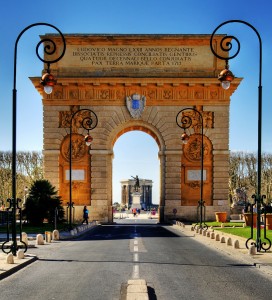
The Arc de Triomphem (L’Etoile), Paris
The Arch de Triumph, which we visited the next day, was imposing. The construction of this was started by Napoleon in 1806 AD as a memorial to the Great Army From there we went to the symbol of Paris, the 1050 ft high Eiffel Tower, which is still the fourth largest edifice in the world. Designed by Gustav Eiffel in the year 1889, it attracts the highest number of visitors in the world. Sadly we bade farewell to Paris and boarded the super fast Eurostar train to London which travels under the Channel.
To my mind, London always conjured images of Charles Dickens, Samuel Johnson and Oliver Goldsmith. Dr. Samuel Johnson said, “When a man is tired of London, he is tired of life, for there is in London all that life can afford”. Here, we were surrounded by history: West Minster Abbey, St. Paul Cathedral, the Houses of Parliament, Buckingham Palace, the Tower of London, Nelson’s column at Trafalgar Square and the statue of Eros at Piccadilly Circus.
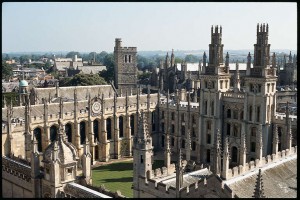
The Oxford University, England
Oxford city, home of the famed University, is one of the most frequently visited and historic cities of Britain. The oldest college in the university dates back to 1249 AD. It has been called the Dreaming Spires and has a unique atmosphere. I could envision Dr. S. Radhakrishnan and Dr. Rafique Zakaria sitting in the staff room. Another great place to visit is Stratford-on-Avon at the edge of the old Forest of Arden. One of the prettiest market towns in England, this is Shakespeare’s birthplace. William Shakespeare’s old writing desk and his bedroom have been perfectly preserved. The visitors’ book upstairs bears signatures of poets like Keats, Shelly and Longfellow. The town has been winning awards every year as the best maintained town in Britain.
Warwick Castle rises majestically from the banks of River Avon, on a site first fortified by William the Conqueror in 1068 AD. Sixty acres of lovely grounds and gardens surround the castle, including the peacock garden where peacocks strut about. The summerhouse has a collection of rare and exotic plants. There are waxworks of occupants of different rooms preparing for a weekend party in 1898. Madame Tussaud wax models were all but live.
The end of a long-awaited European tour leaves me with memories, photographs and tales to tell.
U. Shridhar Rao
2010
http://www.indiatravelogue.com/trav/travmain1.html
Average Rating: 4.6 out of 5 based on 159 user reviews.
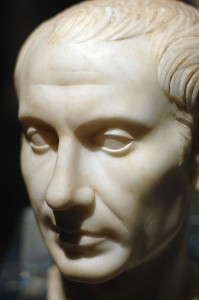 Marble bust of Julius Caesar, first century C.E.; recently discovered on the Island of Pantelleria
Marble bust of Julius Caesar, first century C.E.; recently discovered on the Island of Pantelleria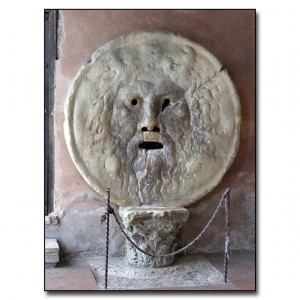 Bocca della Verità or ‘Mouth of Truth’
Bocca della Verità or ‘Mouth of Truth’